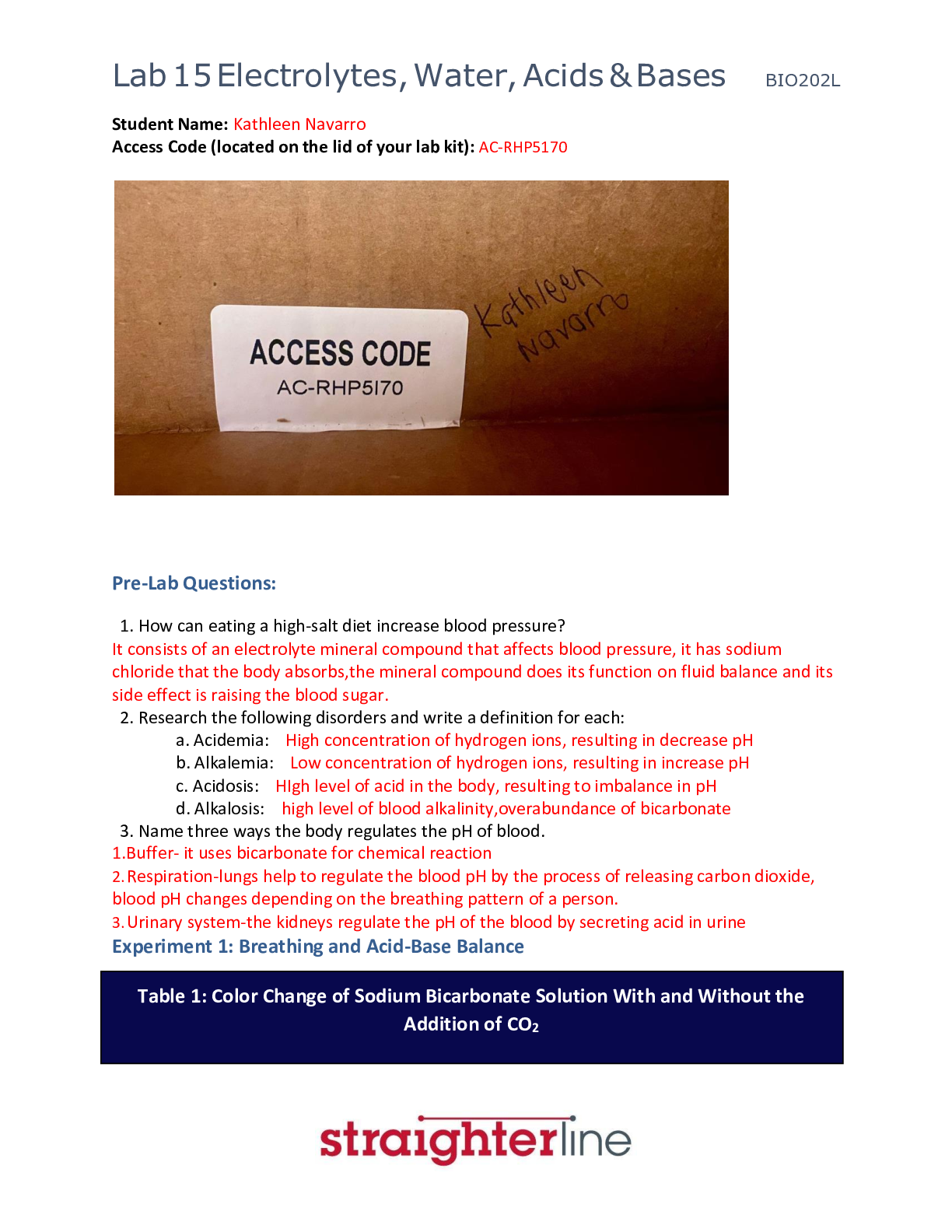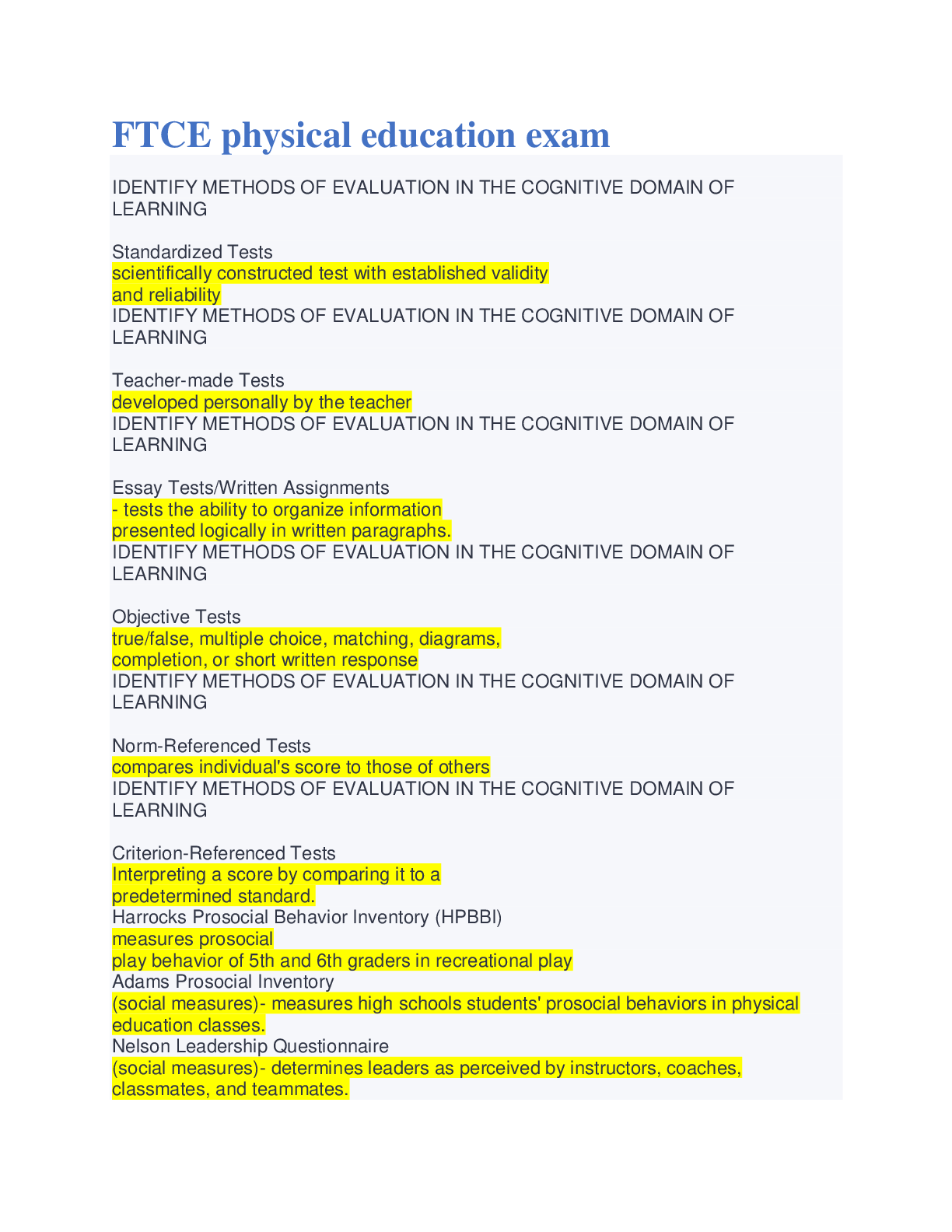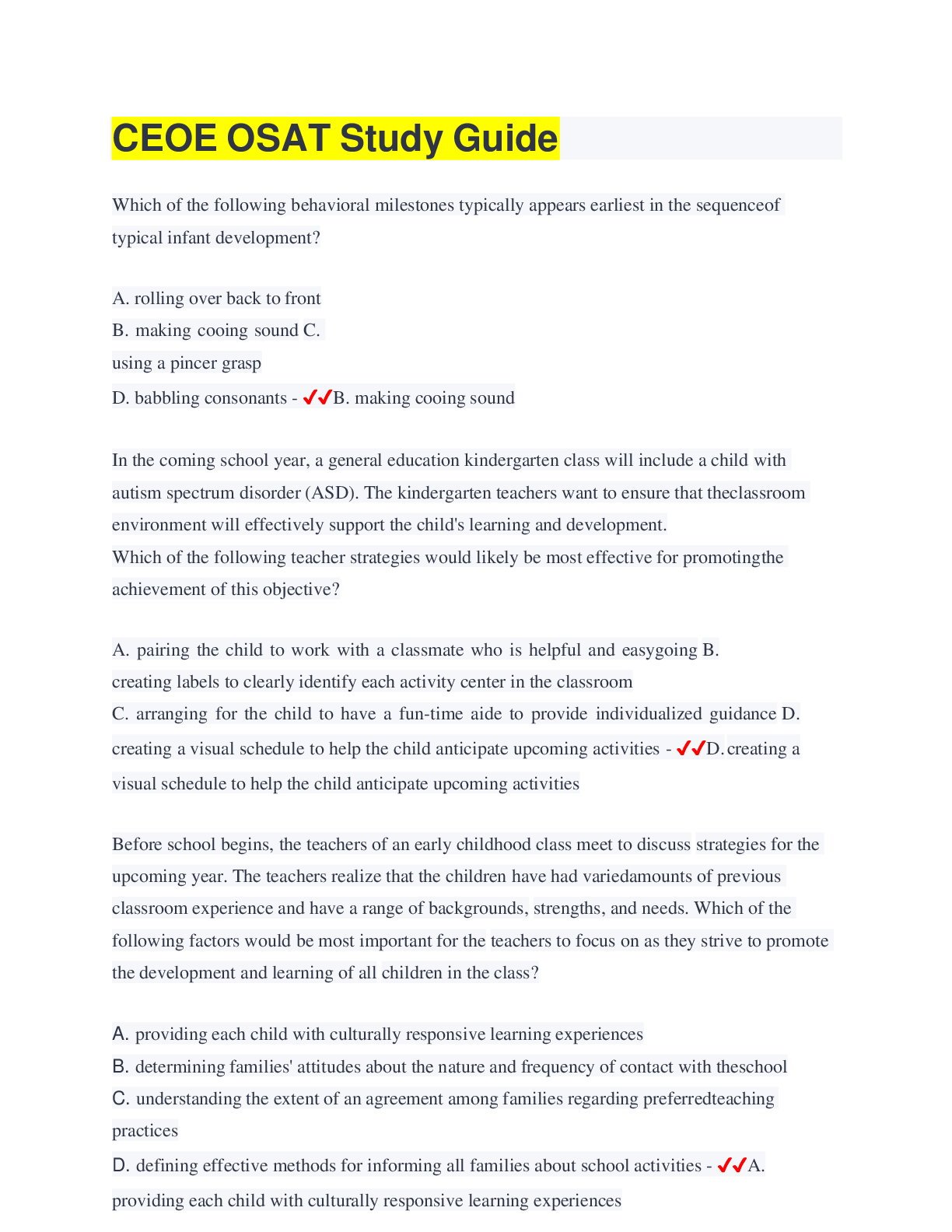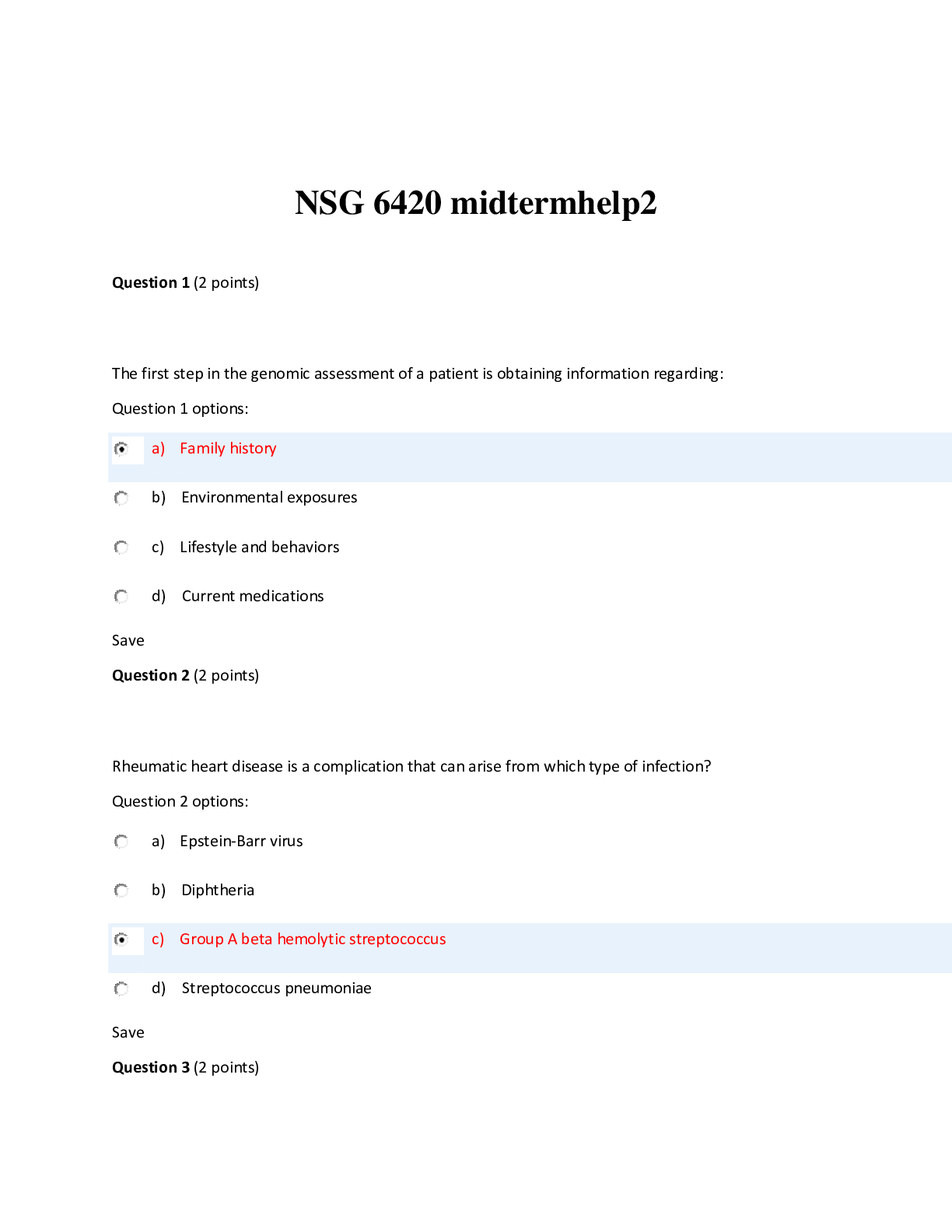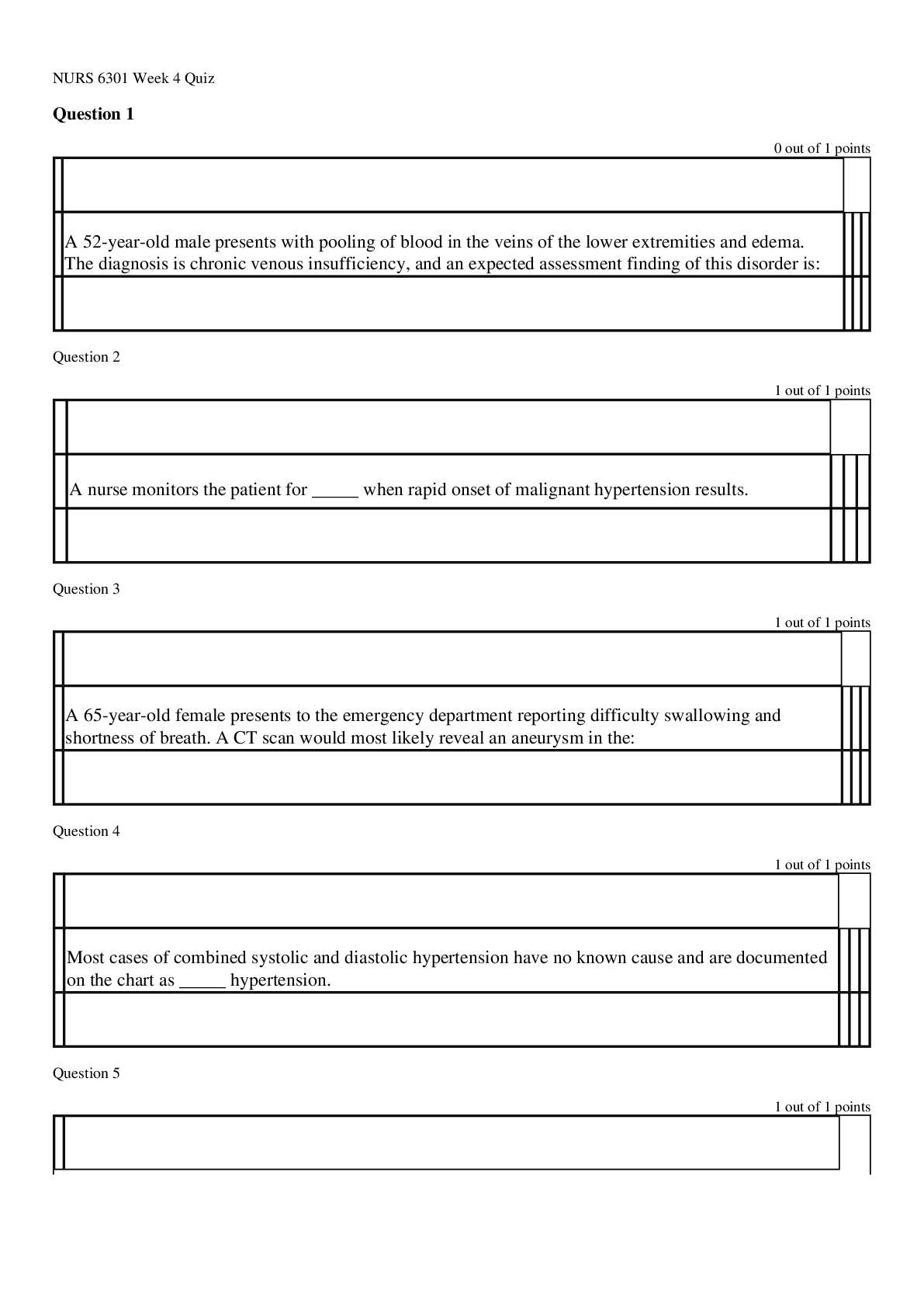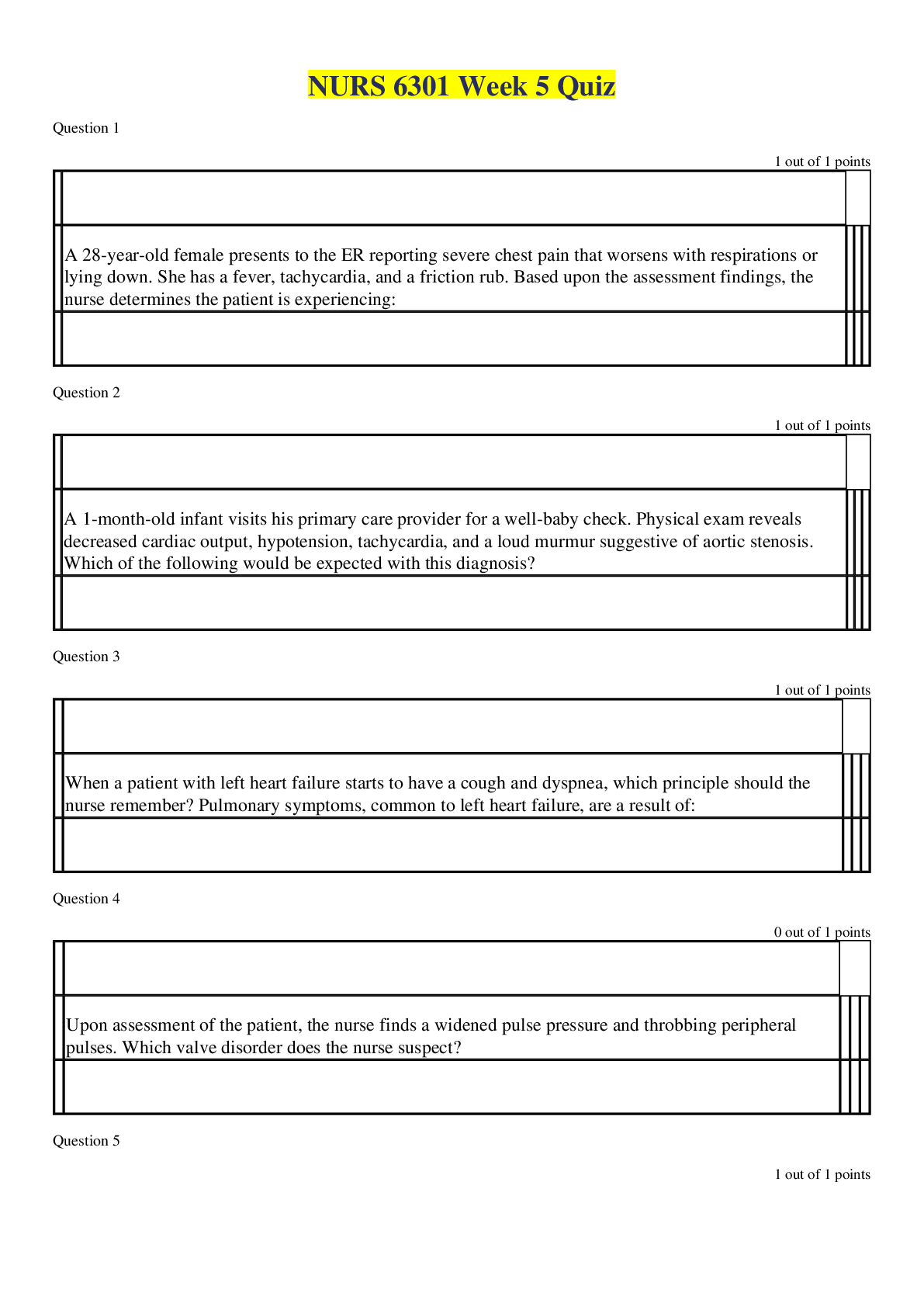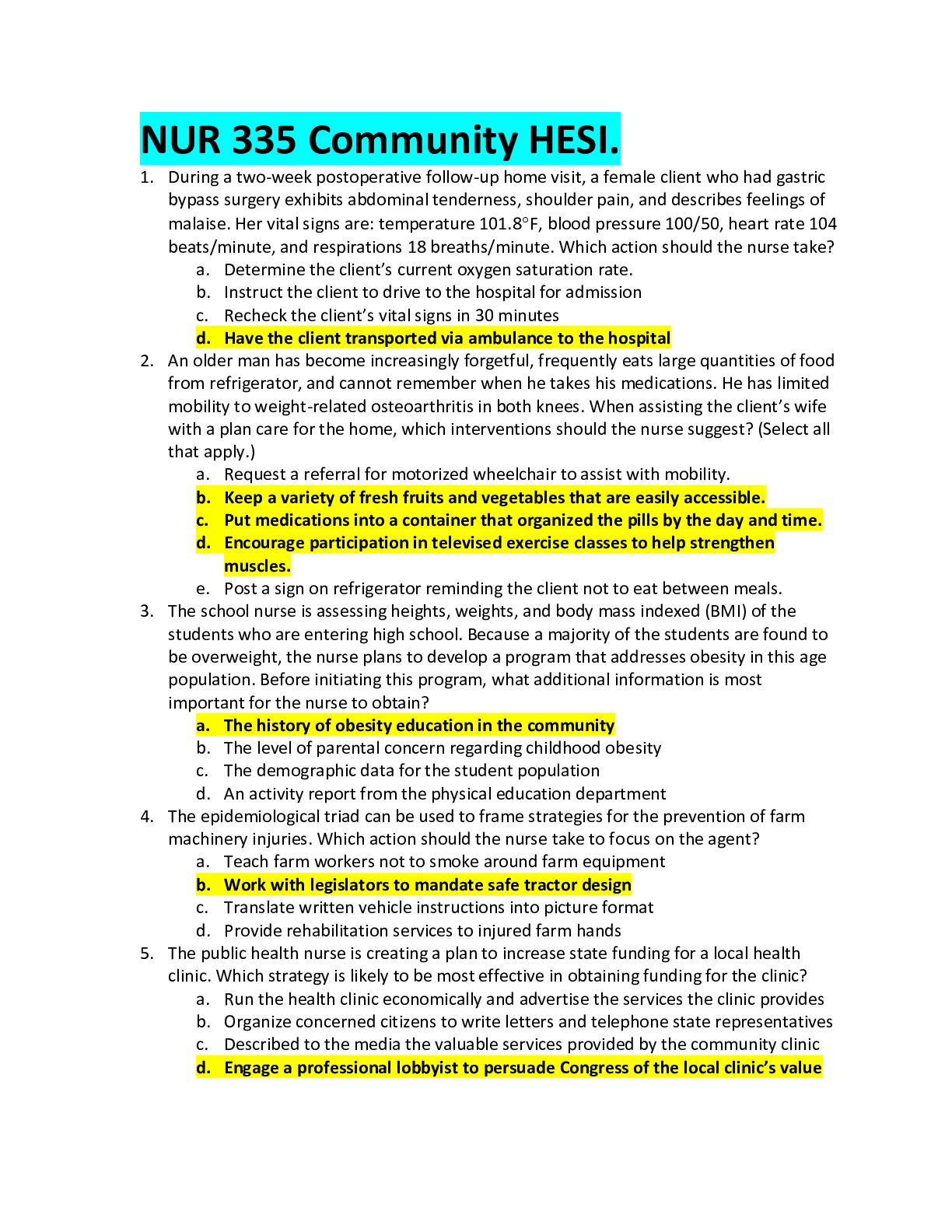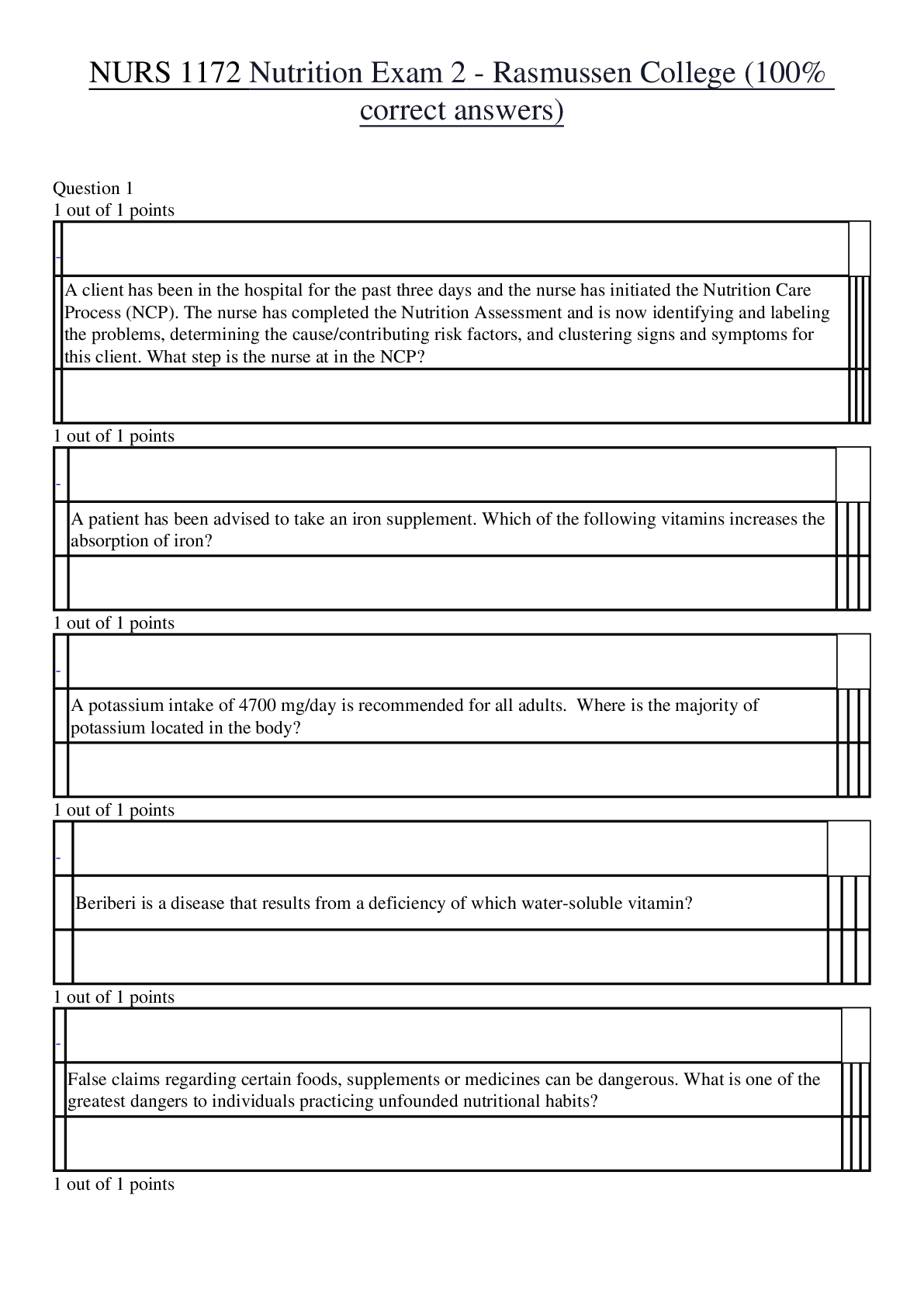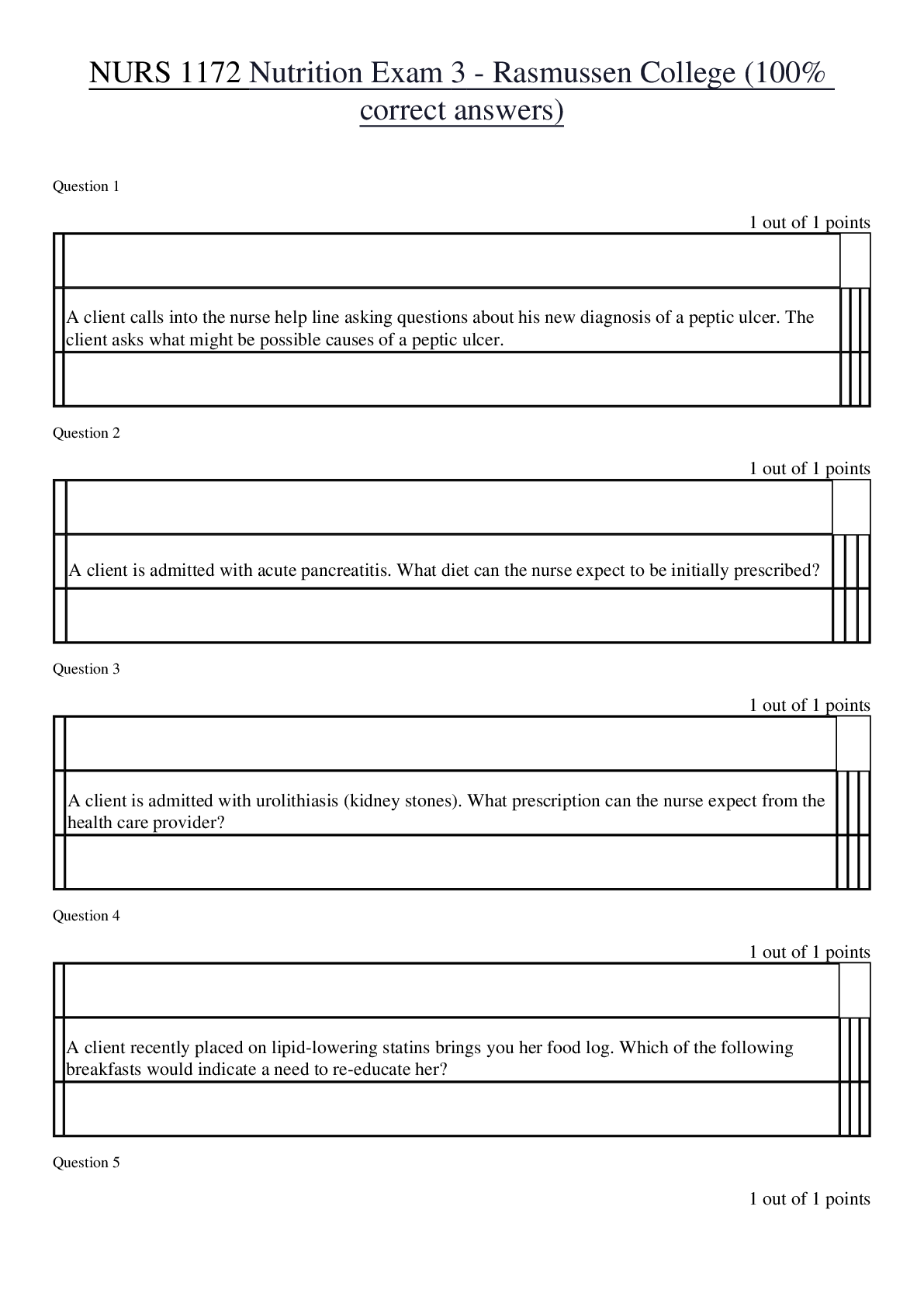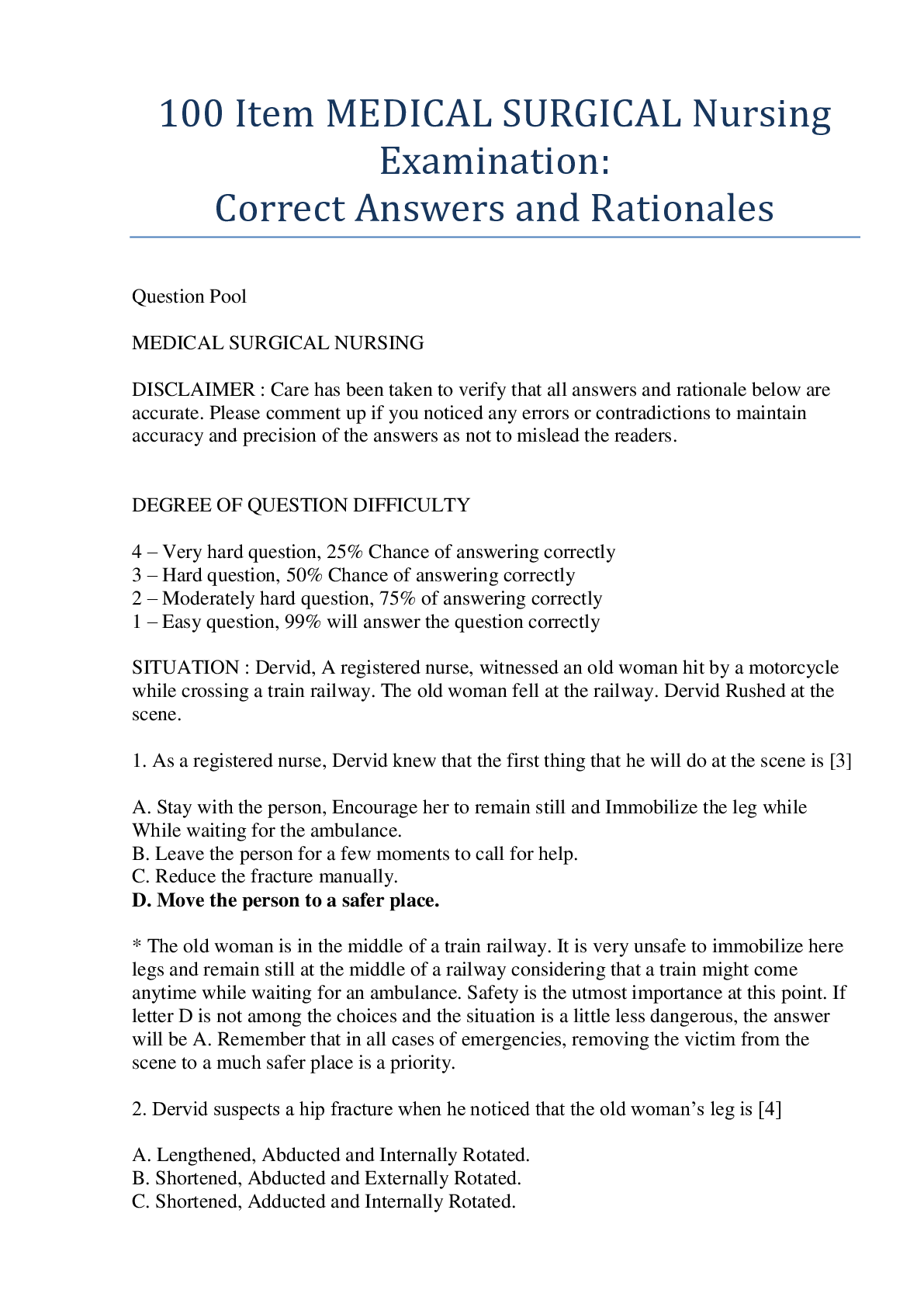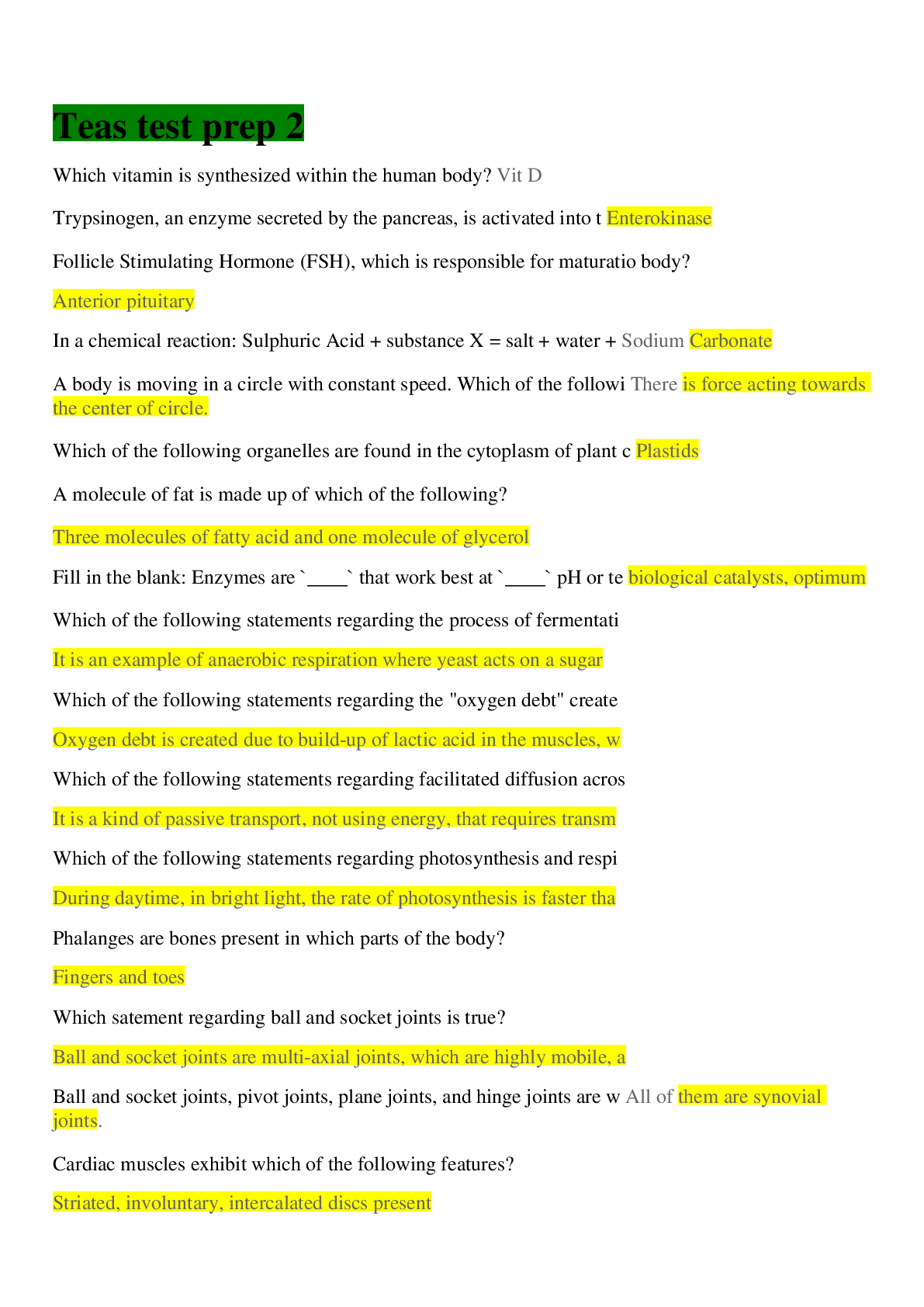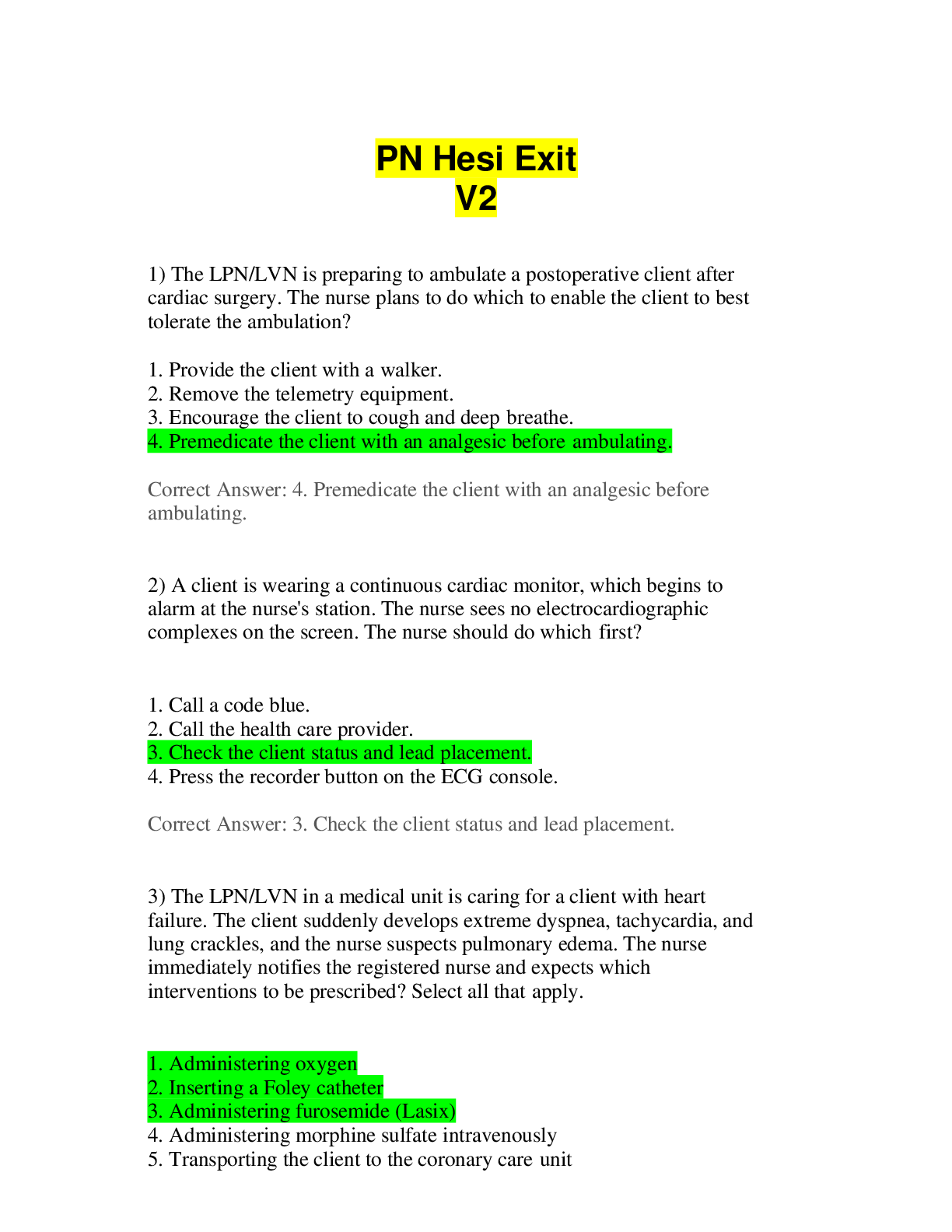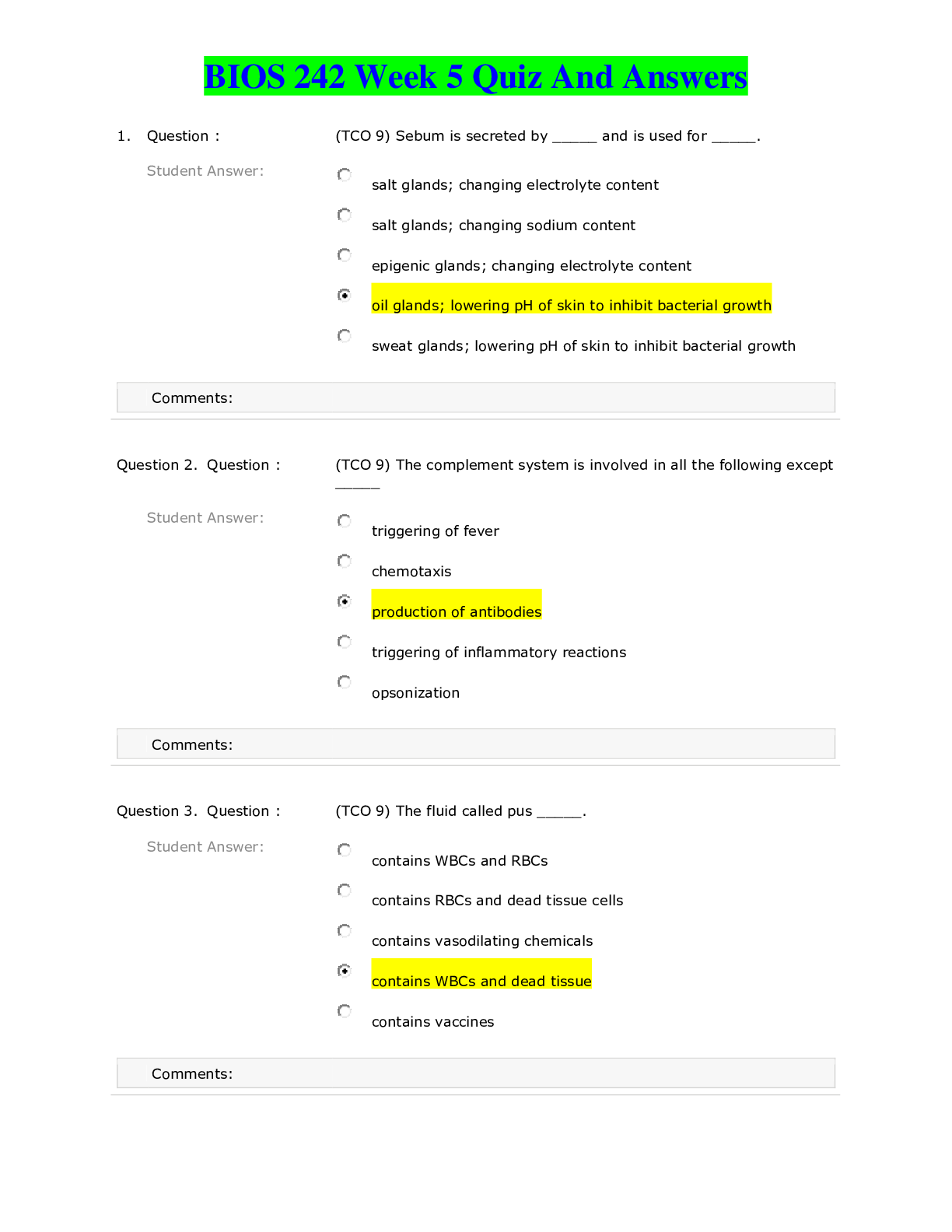*NURSING > EXAM > Family Medicine Board Exam Review 200 Questions with 100% Correct Answers & Explanation (All)
Family Medicine Board Exam Review 200 Questions with 100% Correct Answers & Explanation
Document Content and Description Below
A 42-year-old Asian male presents for follow-up of elevated blood pressure. He has no additional chronic medical problems and is otherwise asymptomatic. An examination is significant for a blood pre... ssure of 162/95 mm Hg but is otherwise unremarkable. Laboratory Findings unremarkable Urine microalbumin negative According to the American College of Cardiology/American Heart Association 2017 guidelines, which one of the following would be the most appropriate medication to initiate at this time? A) Clonidine (Catapres), 0.1 mg twice daily B) Hydralazine, 25 mg three times daily C) Lisinopril/hydrochlorothiazide (Zestoretic), 10/12.5 mg daily D) Metoprolol tartrate (Lopressor), 25 mg twice daily E) Triamterene (Dyrenium), 50 mg daily - ✔✔ANSWER: C This patient has hypertension and according to both JNC 8 and American College of Cardiology/American Heart Association 2017 guidelines, antihypertensive treatment should be initiated. For the general non-African-American population, monotherapy with an ACE inhibitor, an angiotensin receptor blocker, a calcium channel blocker, or a thiazide diuretic would be appropriate for initial management. It is also appropriate to initiate combination antihypertensive therapy as an initial management strategy, although patients should not take an ACE inhibitor and an angiotensin receptor blocker simultaneously. Studies have shown that blood pressure control is achieved faster with the initiation of combination therapy compared to monotherapy, without an increase in morbidity. Lisinopril/hydrochlorothiazide would be an appropriate choice in this patient. -Blockers, vasodilators, - blockers, and potassium-sparing diuretics are not recommended as initial choices for the treatment of hypertension. During rounds at the nursing home, you are informed that there are two residents on the unit with laboratory-confirmed influenza. According to CDC guidelines, who should receive chemoprophylaxis for influenza? A) Only symptomatic residents on the same unit B) Only symptomatic residents in the entire facility C) All asymptomatic residents on the same unit D) All residents of the facility regardless of symptomsE) All staff regardless of symptoms - ✔✔ANSWER: C In long-term care facilities, an influenza outbreak is defined as two laboratory-confirmed cases of influenza within 72 hours in patients on the same unit. The CDC recommends chemoprophylaxis for all asymptomatic residents of the affected unit. Any resident exhibiting symptoms of influenza should be treated for influenza and not given chemoprophylaxis dosing. Chemoprophylaxis is not recommended for residents of other units unless there are two laboratory-confirmed cases in those units. Facility staff of the affected unit can be considered for chemoprophylaxis if they have not been vaccinated or if they had a recent vaccination, but chemoprophylaxis is not recommended for all staff in the entire facility. A 24-year-old female presents with a 2-day history of mild to moderate pelvic pain. She has had two male sex partners in the last 6 months and uses oral contraceptives and sometimes condoms. A physical examination reveals a temperature of 36.4°C (97.5°F) and moderate cervical motion and uterine tenderness. Urine hCG and a urinalysis are negative. Vaginal microscopy shows only WBCs. The initiation of antibiotics for treatment of pelvic inflammatory disease in this patient A) is appropriate at this time B) requires an elevated temperature, WBC count, or C-reactive protein level C) should be based on the results of gonorrhea and Chlamydia testing D) should be based on the results of pelvic ultrasonography - ✔✔ANSWER: A Pelvic inflammatory disease (PID) is a clinical diagnosis, and treatment should be administered at the time of diagnosis and not delayed until the results of the nucleic acid amplification testing (NAAT) for gonorrhea and Chlamydia are returned. The clinical diagnosis is based on an at-risk woman presenting with lower abdominal or pelvic pain, accompanied by cervical motion, uterine, or adnexal tenderness that can range from mild to severe. There is often a mucopurulent discharge or WBCs on saline microscopy. Acute phase indicators such as fever, leukocytosis, or an elevated C-reactive protein level may be helpful but are neither sensitive nor specific. A positive NAAT is not required for diagnosis and treatment because an upper tract infection may be present, or the causative agent may not be gonorrhea or Chlamydia. PID should be considered a polymicrobial infection. Pelvic ultrasonography may be used if there is a concern about other pathology such as a tubo-ovarian abscess. A 24-year-old patient wants to start the process of transitioning from female to male. He has been working with a psychiatrist who has confirmed the diagnosis of gender dysphoria. Which one of the following would be the best initial treatment for this patient? A) Clomiphene B) Letrozole (Femara)C) Leuprolide (Eligard) D) Spironolactone (Aldactone) E) Testosterone - ✔✔ANSWER: E For patients with gender dysphoria or gender incongruence who desire hormone treatment, the treatment goal is to suppress endogenous sex hormone production and maintain sex hormone levels in the normal range for their affirmed gender. For a female-to-male transgender patient this is most easily accomplished with testosterone. When testosterone levels are maintained in the normal genetic male range, gonadotropins and ovarian hormone production is suppressed, which accomplishes both goals for hormonal treatment without the need for additional gonadotropin suppression from medications such as leuprolide. Clomiphene can increase serum testosterone levels, but only in the presence of a functioning testicle. Letrozole is an estrogen receptor antagonist, but it would not increase serum testosterone levels. Spironolactone has androgen receptor blocking effects and would not accomplish either of the hormone treatment goals. Based on American Cancer Society guidelines for cervical cancer screening, when should HPV DNA cotesting first be performed along with Papanicolaou testing? A) At the onset of sexual activity B) At age 21 C) At age 25 D) At age 30 E) At age 35 - ✔✔ANSWER: D According to American Cancer Society guidelines for cervical cancer screening, Papanicolaou (Pap) testing should begin at age 21 irrespective of sexual activity and should be continued every 3 years until age 29. The preferred screening strategy beginning at age 30 is Pap testing with HPV co-testing, which should be continued every 5 years until age 65. Cervical screening may be discontinued at that time if the patient's last two tests have been negative and the patient was tested within the previous 5 years. Long-term proton pump inhibitor use is associated with an increased risk for A) Barrett's esophagus B) gout C) hypertension D) pneumoniaE) type 2 diabetes - ✔✔ANSWER: D Acid suppression therapy is associated with an increased risk of community-acquired and health careassociated pneumonia, which is related to gastric overgrowth by gram-negative bacteria. Long-term treatment of Barrett's esophagus is an indication for chronic proton pump inhibitor (PPI) use. PPI therapy does not increase the risk of gout, hypertension, or type 2 diabetes. An 87-year-old female comes to your office for an annual health maintenance visit. She appears cachectic and tells you that for the past 6 months she has had a decreased appetite and generalized muscle weakness. The patient is alert and oriented to person and place. She has a 10% weight loss, dry mucous membranes, and tenting of the skin on the extensor surface of her hands. While inflating the blood pressure cuff on her right arm you observe carpopedal spasms. Which one of the following is the most likely electrolyte disturbance? A) Hypercalcemia B) Hypocalcemia C) Hypokalemia D) Hypernatremia E) Hyponatremia - ✔✔ANSWER: B A Trousseau sign, defined as spasmodic contraction of muscles caused by pressure on the nerves that control them, is present in up to 94% of patients with hypocalcemia. Hypercalcemia is more likely to present with hyperreflexia. Patients with hypokalemia, hypernatremia, or hyponatremia may present with weakness and confusion, but tetany is not a common sign of either sodium or potassium imbalance. 24-year old female presents to your office with a 3-month history of difficulty sleeping. She says that she struggles to fall asleep and wakes up multiple times at night at least three times a week. She tries to go to bed at 10:00 p.m. and wakes up at 6:30 a.m. to start her day. She lies awake for an hour in bed before falling asleep and spends up to 2 hours awake in the middle of the night trying to fall back asleep. Lately she has been feeling fatigued and having difficulty concentrating at work. You conduct a full history and physical examination and tell her to return in 2 weeks with a sleep diary. At this follow-up visit you see from her diary that she is sleeping an average of 5½ hours per night. Which one of the following would be the most appropriate recommendation? A) Set her alarm for 5:30 a.m. B) Add a mid-afternoon nap C) Move her bedtime to 9:00 p.m. D) Move her bedtime to 12:30 a.m. [Show More]
Last updated: 2 years ago
Preview 1 out of 111 pages
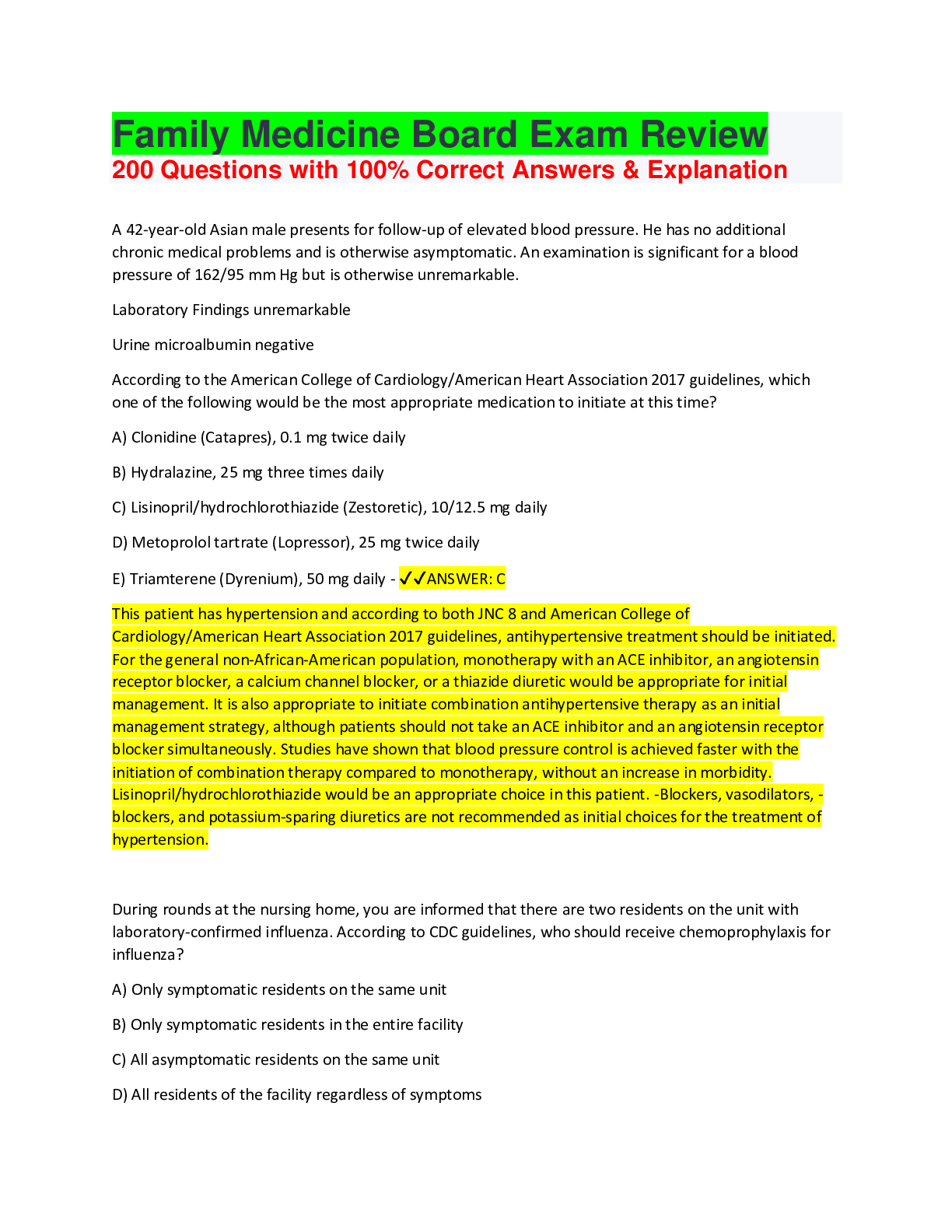
Buy this document to get the full access instantly
Instant Download Access after purchase
Buy NowInstant download
We Accept:

Reviews( 0 )
$12.00
Can't find what you want? Try our AI powered Search
Document information
Connected school, study & course
About the document
Uploaded On
May 17, 2022
Number of pages
111
Written in
Additional information
This document has been written for:
Uploaded
May 17, 2022
Downloads
0
Views
102









